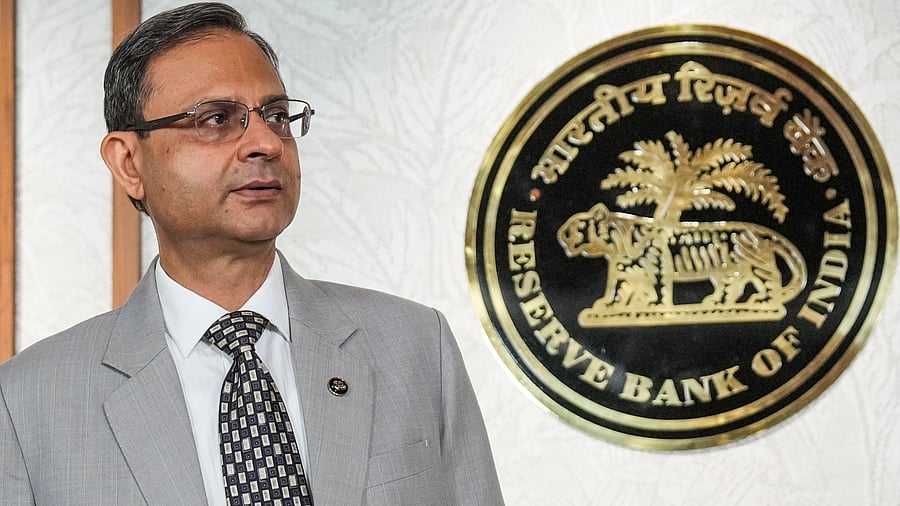
RBI Governor Sanjay Malhotra.
Credit: PTI Photo
New Delhi: The Reserve Bank of India (RBI) on Friday cut key policy interest rates by a larger-than-expected 50 basis points, a move that will lead to a drop in EMIs on home, auto and other loans and boost economic growth by reinvigorating credit cycle as inflation remains muted.
This 50-basis-point (0.5%) reduction is the steepest rate cut by the RBI since the emergency 75-basis-point easing in March 2020, when the economy was under severe strain due to the Covid pandemic.
The repo rate, the interest at which the RBI lends money to commercial banks for their short-term needs, has been cut to 5.5% with immediate effect, from the earlier 6%.
The standing deposit facility (SDF) rate under the liquidity adjustment facility has been cut to 5.25% and the marginal standing facility (MSF) rate and the bank rate to 5.75%.
A majority of the lending and deposit rates offered by the commercial banks are guided by these RBI’s policy rates.
In a bid to boost liquidity, the RBI decided to cut the cash reserve ratio (CRR) by 100 basis points to 3% in a phased manner. This move is expected to infuse Rs 2.5 lakh crore primary liquidity to the Indian banking system by December.
“It will enhance systemic liquidity and provide additional lending capacity to the banking sector,” said Ashok Chandra, Managing Director, Punjab National Bank.
The RBI has lowered the policy repo rate by 100 bps in the past 4 months. It was cut by 25 bps in February and again by the same magnitude in April.
A majority of the analysts were expecting 25 bps this time also. The 50 bps reduction has been termed as a “jumbo” rate cut.
RBI Governor Sanjay Malhotra termed the move as “frontloading” of the rate cuts. This means a 25 bps rate cut, which was expected in August or October, has been advanced to send a stronger message to consumers and investors.
“It is imperative to continue to stimulate domestic private consumption and investment through policy levers to step up the growth momentum. This changed growth-inflation dynamics calls for not only continuing with the policy easing but also frontloading the rate cuts to support growth,” Malhotra said.
Harsha Vardhan Agarwal, President of industry chamber FICCI, said the frontloaded rate cut “sends a strong signal of the RBI’s commitment to supporting growth”. “The move is timely and will help boost domestic demand, encourage credit offtake, and inject further momentum into economic activity,” Agarwal added.
Five of the six members of the RBI’s Monetary Policy Committee (MPC), including Malhotra, voted for the 50 bps cut. One external member Saugata Bhattacharya voted for a smaller 25-bps cut.
The MPC also decided to change the stance from “accommodative” to “neutral”. This means the RBI is no longer committed to only cutting rates as in an accommodative stance, but is now open to either hiking or further reducing rates based on evolving economic data.
“From here onwards, the MPC will be carefully assessing the incoming data and the evolving outlook to chart out the future course of monetary policy in order to strike the right growth-inflation balance,” RBI Governor said.
State Bank of India Chairman CS Setty termed the monetary policy announcements as “out of the box and an unanticipated surprise.”
“The MPC has broadly addressed any concerns on slowdown in growth on account of global uncertainties and fully capitalised on the softening domestic inflation to deliver a frontloaded rate cut, staggered durable liquidity injection yet conserving the space for future action,” Setty said.
Positive signal Reduction is the steepest rate cut by the RBI since the emergency 75-basis-point easing in March 2020 RBI Guv terms move as “frontloading” of rate cuts; meaning a 25 bps rate cut expected in Aug/Oct has been advanced The RBI has lowered the policy repo rate by 100 bps in the past 4 months Rs 2.5 lakh crore liquidity to be infused through CRR cut by Dec, boosting banking sector's additional lending capacity
Quote - It is imperative to continue to stimulate domestic private consumption and investment through policy levers to step up the growth momentum. This changed growth-inflation dynamics calls for not only continuing with the policy easing but also frontloading the rate cuts to support growth - Sanjay Malhotra RBI Governor
Sensex Nifty surge after RBI move Benchmark indices Sensex and Nifty surged nearly 1% on Friday driven by a rally in rate-sensitive sectors following the Reserve Bank of India's rate cut of 50 basis points. Market analysts said in light of benign inflation forecasts RBI has taken steps to boost growth.